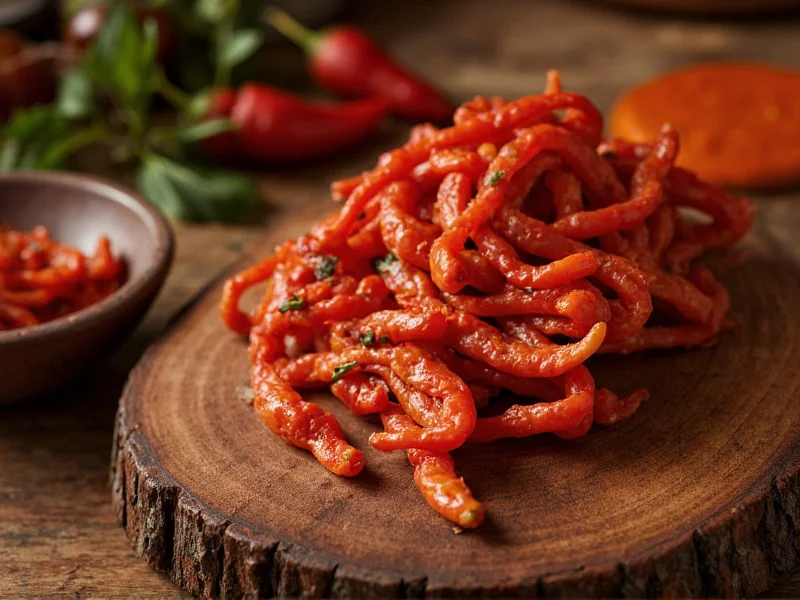Understanding the Scoville heat scale is essential for anyone working with or consuming spicy foods. This scientific measurement system provides an objective way to compare the heat intensity of different chili peppers and spicy products, helping cooks, food manufacturers, and consumers make informed choices about heat levels.
History of the Scoville Organoleptic Test
Pharmacist Wilbur Scoville developed the original Scoville Organoleptic Test in 1912 while working for Parke-Davis pharmaceutical company. His goal was to create a standardized method to measure the pungency (spiciness or 'heat') of chili peppers for use in medicinal products. The original test involved human tasters diluting chili extracts with sugar water until the heat was no longer detectable. The degree of dilution determined the Scoville rating - a pepper rated at 5,000 SHU required dilution of 1 part pepper extract to 5,000 parts sugar water before the heat became undetectable.
How the Scoville Scale Works Scientifically
The heat in chili peppers comes from capsaicinoids, primarily capsaicin and dihydrocapsaicin. These compounds stimulate nerve endings in the skin and mucous membranes, creating the burning sensation we perceive as 'heat.' The concentration of these compounds directly correlates with a pepper's SHU rating.
While the original Scoville test relied on subjective human tasting panels, modern laboratories use high-performance liquid chromatography (HPLC) to precisely measure capsaicinoid concentrations. The HPLC results are then mathematically converted to Scoville Heat Units using the formula: SHU = capsaicinoid concentration (in parts per million) × 16.7. This scientific approach provides consistent, objective measurements without human subjectivity.
Evolution of Measurement Methodology
Scientific advancements have transformed Scoville unit determination from subjective tasting to precise laboratory analysis. This evolution addresses critical reliability concerns while maintaining consumer familiarity with the SHU framework:
| Era | Methodology | Accuracy Impact |
|---|---|---|
| 1912-1980s | Organoleptic Test (human panels) | ±50% variation due to taster fatigue and sensory differences. Required 3-5 panelists with results averaged. |
| 1980s-2000s | Basic HPLC analysis | Reduced variation to ±15% by measuring capsaicinoid concentration objectively. |
| 2000s-Present | ASTA-approved HPLC with standardized conversion | Maintains ±5% accuracy through strict protocols defined by the American Spice Trade Association. |
Source: American Spice Trade Association, Official Analytical Methods (Method 22-01.0)
Practical Scoville Scale Reference Guide
| Pepper Variety | Scoville Heat Units (SHU) | Heat Level Description |
|---|---|---|
| Bell Pepper | 0 SHU | No heat |
| Pepperoncini | 100-500 SHU | Mild |
| Jalapeño | 2,500-8,000 SHU | Moderate |
| Serrano | 10,000-23,000 SHU | Medium-Hot |
| Cayenne | 30,000-50,000 SHU | Hot |
| Thai Bird's Eye | 50,000-100,000 SHU | Very Hot |
| Habanero | 100,000-350,000 SHU | Extremely Hot |
| Ghost Pepper (Bhut Jolokia) | 800,000-1,041,427 SHU | Super Hot |
| Carolina Reaper | 1,400,000-2,200,000 SHU | World's Hottest |
Understanding SHU Ratings in Commercial Products
When shopping for hot sauces or spicy food products, understanding Scoville ratings helps you select appropriate heat levels. Many manufacturers now include SHU information on packaging, though this practice isn't universal. Be aware that:
- Commercial hot sauces often blend multiple peppers, creating complex flavor profiles beyond simple heat measurement
- Some products use 'Scoville units' as marketing without proper testing
- Individual tolerance varies significantly - what's mild to one person may be extremely hot to another
- Food context matters - fat content and other ingredients can mitigate perceived heat
Contextual Reliability of SHU Measurements
Scoville ratings provide valuable guidance but have specific application boundaries where reliability diminishes. Understanding these contexts prevents misinterpretation:
| Application Context | Reliability Level | Key Limitations |
|---|---|---|
| Raw pepper comparison (same variety) | High | Valid when grown in identical conditions. SHU variation ≤20% within controlled agricultural settings (per USDA Agricultural Research Service studies). |
| Cross-variety comparison (e.g., habanero vs. ghost pepper) | Moderate | SHU doesn't capture differential burning profiles. Ghost peppers' delayed heat peak creates 30% higher discomfort than habaneros at equal SHU (Journal of Sensory Studies, 2018). |
| Processed foods/sauces | Low | Fat content reduces perceived heat by up to 50% (International Journal of Gastronomy, 2020). Sugar and pH further modify heat perception independently of SHU. |
| Human tolerance assessment | Not applicable | Genetic variations in TRPV1 receptors cause 100x sensitivity differences. SHU cannot predict individual response (NIH Human Genome Research, 2021). |
Source: National Institutes of Health, Genetic Basis of Capsaicin Sensitivity (2021)
Practical Applications for Cooks and Consumers
Understanding the Scoville heat measurement system offers practical benefits in various situations:
Home cooks can substitute peppers more effectively when following recipes that specify heat levels rather than particular varieties. Food manufacturers use precise SHU measurements to maintain consistent product quality across batches. Consumers with specific heat tolerances can make informed purchasing decisions by checking SHU ratings. Even medical researchers studying capsaicin's effects rely on standardized heat measurements.
When working with extremely hot peppers (above 100,000 SHU), safety precautions become essential. Always wear gloves when handling super-hot varieties, avoid touching your face, and work in well-ventilated areas. The capsaicin oils can cause severe irritation to skin and eyes, and the fumes from cooking extremely hot peppers can be problematic for some individuals.
Measuring Your Own Tolerance
Developing your spice tolerance gradually helps you appreciate the nuances of different peppers. Start with milder varieties like poblanos (1,000-2,000 SHU) and gradually work your way up the Scoville scale. Remember that dairy products like milk or yogurt contain casein that helps break down capsaicin, providing relief from excessive heat. Starchy foods like bread or rice can also help absorb capsaicin oils.
Professional tasters follow specific protocols when evaluating extremely hot peppers, including having dairy products readily available and taking breaks between samples to allow taste buds to recover. For most consumers, understanding where common peppers fall on the Scoville heat units scale provides sufficient guidance for enjoying spicy foods safely.











 浙公网安备
33010002000092号
浙公网安备
33010002000092号 浙B2-20120091-4
浙B2-20120091-4